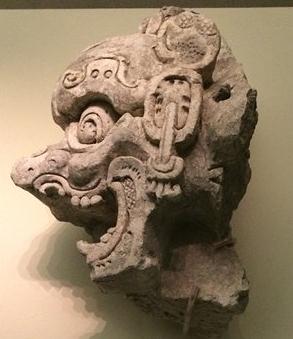

Effigy of Chaak, the rain god from Late Postclassic (1250-1550) Photo: Xiong Yuqing/GT
"Mysterious," might be the first word that come to most Chinese people's minds when thinking about the ancient Maya, a civilization whose name has been appearing quite frequently in China recently, mostly linked to its amazing astronomy, advanced mathematics and of course doomsday predictions such as those that helped Roland Emmerich's 2012 (2009) earn over 400 million yuan ($65 million) at the Chinese mainland box office.
Typing in Maya on China's largest search engine Baidu returns 53 million results - of which 4 million are related to Maya culture, 3.5 million about Maya civilization and 2.8 million about Maya predictions about the end of the world (most of which are fake) - which shows the great curiosity people in China have about this ancient culture that existed on the other side of the world.
A new exhibition, Maya: The Language of Beauty, sets out to satisfy this curiosity. Scheduled to run until March 8, 2015, the ongoing exhibition at the National Museum of China brings 238 artifacts collected from more than 20 museums to the capital. For some of these precious objects, including the 2-ton Stela with a Ruler (600-900), the exhibition marks the first time they have been shown outside of Mexico.
To mark the importance of the exhibition, Chinese President Xi Jinping and Mexican President Enrique Peña Nieto attended the opening ceremony on Thursday. In a speech, Xi took note of the two countries' long history, splendid culture and contributions to the progress of human civilization, while also mentioning how deeply impressed he was by the Chichen Itza ruins during his visit to Mexico last year. During his time on stage, Peña Nieto explained his hope was that the Maya civilization could act as a bridge between the two counties and invited Chinese people visit to Mexico to experience the local culture.
Unusual beauty
Located in what is now Mexico, Guatemala, Honduras and El Salvador, Maya civilization first formed around 10th century BC and reached its peak during the 3rd to 9th centuries AD. Today, the approximately 6 million strong Maya community takes great pride in their 3,000-year-old history and culture.
"We've discovered that Chinese people know a lot about Maya mathematics and astronomy, but less about other aspects of the culture. So we decided to pay more attention to the way the Maya people saw themselves," said Tong Chunyan, the Chinese curator for the exhibition.
The exhibition is divided into four sections: The Body as Canvas, The Clothed Body, The Animal Alter Ego and The Bodies of the Divine. The first two sections delve into the Maya people's aesthetic traditions and views on the human body. Sculptures in this area show this appreciation of the human form by depicting little people and figures afflicted with Ascites disease, a disease that causes people to develop overlarge bellies. The ancient Mayas believed these people had the ability to connect with supernatural.
A special set of exhibitions depict the Maya tradition of "head shaping," a popular practice among the ancient Mayas in which mothers used boards to alter the shape of their newborns' skulls. Along with other visible markings such as painted skin, tattoos and large earlobes, this cranial deformation represent the culture's unique aesthetic preferences.
The third section examines the Mayas' relationship with animals, which they believed were capable of speech and possessed supernatural powers. For instance, as birds that can fly, swim and walk, waterfowl were believed to be supernatural creatures that connected the upper-world, the under-world and the world of man.
"The exhibition focuses on Maya ideas of beauty. Just like other parts of the world, the aesthetics of the Maya people were expressed in many different ways, and finally became a unique form of art," said José Enrique Ortiz Lanz, the manager of museums and exhibitions for the National Institute of Anthropology and History in Mexico.
Five tourists saved from Maya Snow Mountain in NW China
2014-07-21Copyright ©1999-2018
Chinanews.com. All rights reserved.
Reproduction in whole or in part without permission is prohibited.